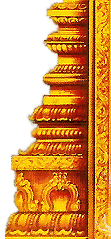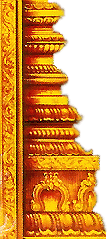Emperor Mushukunda got seven Lingas from Indira for the helps he had rendered him. These Lingas were small – Vidanga in size. The Emperor installed the Linga in Seven Places called Saptha Vidanga sthalas. This is one such Sthalas with a Linga so beautiful made of Ruby. Hence, the Lord is named Sundara (beautiful) Vidangar. Lord Thyagaraja is in a separate shrine right of the sanctum sanctorum. In majority of the temple, people can see only the face of Lord Thyagaraja. During the Vaikasi Visaka and Margazhi Tiruvadirai festivals, Lord is dressed (Alankara) showing His right hand and feet. Lord comes in procession waving His hands to and fro and in a dancing form. This dance is called Paara Vaara Natanam.
The eyes of Mother Ambica is blue in colour as sea showing Her mercy as vast and deep as sea. Hence, named Neelayadakshi-blue eyed. She is also Karundhadanganni. She has Her own shrine with a flag post-Kodi Maram. Ambica graces as a virgin. Aadi Pooram is very grandly celebrated in the temple. Her shrine is designed as a Rath. On the festival day, Mother comes in procession in a Rath made purely in crockeryware.
As Ambica is a virgin, Lord sent Nandhi Deva to be Her guard. But Nandhi expressed his wish to be with Lord for ever seeing Him. Lord said that he can have His darshan though with Ambica. Nandhi in the temple is seen with its neck turned towards Lord with one eye on Ambica and other on the Lord. Hence, the Nandhi is known as Twin View Nandhi (Irattai Parvai in Tamil). Those having vision problems pray to this Nandhi.
Generally, temples are closed if a death occurs in a nearby place. In this place, the garlands and the clothes – vastras used for the Lord is placed on corpse. A fisherman, Adhipathar attained salvation with the grace of Lord Shiva in this place. Remembering this event, as a mark of respect to the community, this practice is followed in this temple. The body is placed before the temple without closing the doors. The garland and the vastras used for the Lord are placed on the body.
During festival procession, Lord goes round the Mada Veedhis (Streets) and return to the temple. But Lord beginning his procession from this temple, goes to seven places – Poigainallur, Poravacherry, Sikkal, Palur, Vadagudi, Thethi and Nagoor. Maharaja Salija worshipped Lord Shiva and performed puja in these seven places. The present system is to remember this history.
Against the practice of Lord coming in the Vrushab vahan on Pradosham days, Lord Vishnu too accompanies Lord Shiva in the guise of Mohini. When the milk ocean was churned, Nectar came out and was served by Lord Vishnu to Devas. Devas failed to pray to Lord Shiva who swallowed the Halahala poison to save the world. Realizing their folly, they begged the pardon of the Lord. Showing His mercy to them, Lord Shiva danced on Nandhi. This dance took place at the Pradosham time. Lord Vishnu’s Mohini Avtar took place a little before this time. This Vishnu darshan is available to the devotees on Pradosham day only.
Emperor Dasaratha came to know that Planet Saturn would be splitting the Rohini star causing severe famine in his country. He planned to fight Saturn to prevent him from doing so. Sun God advised Dasaratha to drop his plan but to beg Saturn to change his transit route in public interest. Saturn also admired the earlier plan of the emperor to meet him in war for the sake of his subjects without any selfish motive personally. The planet yielded to the emperor’s wish. Remembering this event, all the planets (Navagrahas) in the temple are facing west-the Lord.
Fisherman Athipathar was a staunch Shiva devotee. When he went for fishing, he would offer the first to Lord Shiva. At a stage, he was getting only one fish each day but did not break away from his commitment. He offered them to Lord and returned without any catch. He got a golden fish one day. Though every one prevented him from throwing it into the sea, Athipathar resolutely stood by his commitment and threw it into the sea. He was awarded with salvation and a place among the 63 Nayanmars. The event is celebrated on the Ayilyam star day in Aavani month (August-September). Athipathar goes in catamaran when fishermen place two gold fishes in the net as if caught in the net. Lord Shiva will appear on the sea shore. Athipathar performs pujas to Lord Shiva with the golden fishes. Shiva will grace darshan to Athipathar. So goes the festival grandly.
As a child adamantly demanding the mother to get its wish, there was a Siddha in the place called Azhuguni Chithar – crying adamantly for a wish. He used to cry in the shrine of Mother Neelayadakshi demanding salvation. He was the disciple of Gorakka Siddha. He stayed in the temple, cried for getting his demand. Mother spoke to Lord Shiva of the issue. Lord granted salvation to Azhuguni Chithar. His Jeeva Samadhi is in this temple. Special pujas are performed to Siddha on Vaikasi Visakam day. Also special pujas are performed here offering porridge (Payasam in Tamil) as nivedhana on poornima –full moon – days.
Lord Vinayaka graces His darshan wearing a serpent around His body with another one another one above His head as an umbrella. He is worshipped as Nagabarana Vinayaka. Those facing adverse serpent planet effects perform milk abishek to Nagabarana Vinayaka at Rahu Kalam times. Also during the transit of these planets in the zodiac circle, special pujas are performed here to please the planets.
Lord Bhairava, usually appearing with His dog vehicle, has Lion – Simha as his vahan. When Sage Pundarika worshipped Lord Shiva here, Holy Ganga sprang up in this place along with Lord Bhairava. He is gracing as Kala Samhara Bhairava in this temple. The Simha vahan is behind Him. It is believed that Lord Shiva Himself is gracing the devotees who hit Yama the God of Death. As Lord Kala Bhairava is facing South, devotees pray to him for longevity. As He looks furious, two smiling Vinayakas are installed before Him.
There is a shrine for Mother Ashta Bhuja (eight hands) Kali in the temple.
The deities for the eight directions have their due place in the temple. Mother Gajalakshmi in Her sitting form graces the devotees with two elephants offering abishek. Lord Dakshinamurthi is in the ghoshta wall with His four disciples. As the temple is on a sea shore, it is said that Lord Shiva is ruling the region as a king, hence the name Shiva Rajadhani –capital of Shiva Kingdom.
The temple is greatly praised by the three celebrated saints Sambandar, Appar and Sundarar in their Thevaram hymns. Sundarar received gifts of pearl and diamond chains, a horse and cosmetic things. Sages Markandeya, Gauthama, Vasishta, Kashyapa, Pulasthya, Agasthya and Angirasa (Saptha Rishis) had worshipped Lord Shiva in this temple.
Behind the Linga in the sanctum sanctorum is the Somaskanda form of Lord Shiva. Lord Shiva comes to the sea for a bath on the Masi Magam day in February-March.
The idol of Lord Muruga is made with 12 hands with weapons. He is praised in the Tirupugazh hymns of saint Arunagirinathar. The Zodiac circle is in the Mandap. People pray from here for relief from planetary problems. The event of sage Pundarika entering the shrine of Lord Shiva and merging with Him is celebrated during the Arthajama Puja (the last puja of the day) on the Ayilyam star day in the month of Aani-June-July. Sri Chandikeswara shrine is on the side of prakara. |





